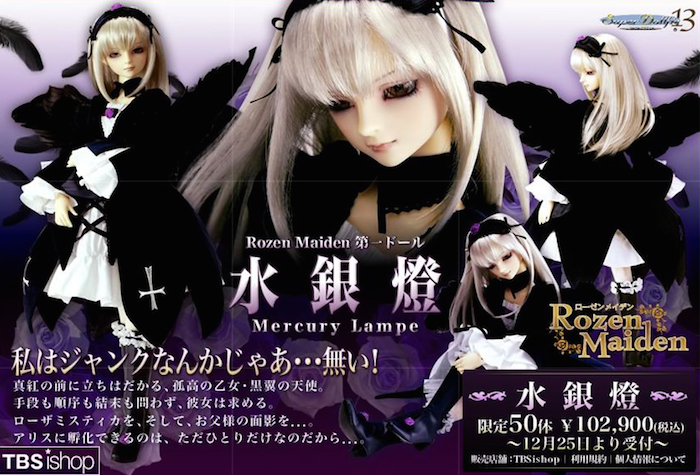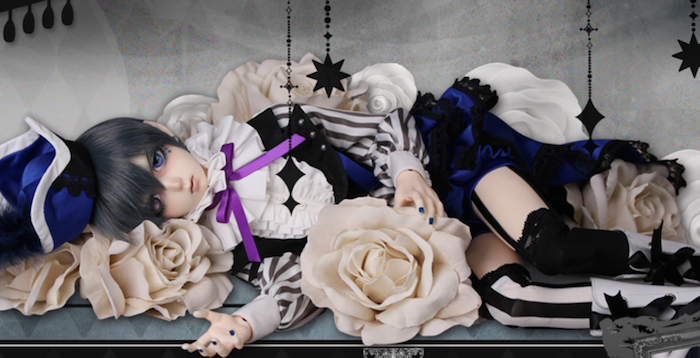
Otaku Wonderland Part 4: Where Angels Tread
- Details
- Written by Elena Tessari

In past articles we discussed some of the otaku world's most relevant marketing and collecting phenomena, especially in relation to anime, manga, video games and figure. From now on we will focus on a particular sector dominated by women collectors, little known but still multi-faceted and fascinating: dolls collecting.
We should make a first distinction between two very different kinds of dolls: ball joint dolls and fashion dolls. In this article we will discuss the first type.

Foto di gruppo con Super Dollfie
Ball Joint Dolls, as an invention, are neither modern nor Japanese. Still, today the world of bjd (acronym for ball joint dolls) is tightly associated with Asian dolls and collecting, mostly due to the trend finding its roots about twenty years ago in Japan, Korea and China.
The first modern bjd were produced by Japanese maker Volks, better known back then for its garage kits and figure. Inspired by sculptor Enku Akihiro, Volks decided to produce a doll line targeted to women: the Super Dollfie. These dolls are still a bestseller, and are available as aseemble-requiring kits. Height varies from 26,5cm for the YoSD to 65cm for the SD17.
From 2003 Volks expanded into overseas markets, opening its Tenshi-no-sumika (Angel Residences) all over the world, from Korea to he States. There have also been collaborations with many lolita fashion brands, such as Baby, The Stars Shine Bright or H. Naoto, as well as anime like Rozen Maiden (whose protagonists are bjd-like dolls), Maria-sama ga Miteru or Gosick.

Suigintō Super Dollfie from the Rozen Maiden anime, priced at 102.900 yen
The price tag for a brand new SD varies from 35-40 thousand yen (about 300 euros) for an unassembled starter kit, all the way to 150 thousand yen (about 1200 euros) for limited runs or exclusive models. Because of their high production value, some pieces (or the intact mold for a head, or an outfit) can be worth hundreds of thousands of yen in the second hand market.

Hatsune Miku Super Dollfie (standard, Snow Miku and Senbonzakura)
A line aside is Dollfie Dream (DD), vinyl and resin dolls designed for a male audience. Many of the available characters come from shōnen/seinen manga or ero-games, and feature prominent breasts and nipples. Some examples are Evangelion's Ayanami Rei, Saber Alter from Fate/Stay Night, and the well known Hatsune Miku, for which the exclusive Snow Miku edition, or just the swg+outfit set is available. A standard version goes for about 500 euros.

An SD 'visiting' the Tenshi-no-sato
The community surrounding BJD and SD is fairly interesting as well.
In Kyoto, Volks opened the Tenshi-no-sato (天使の里 “Angel's Homeland”), a museum which displays rare models, as well as functioning as a hub for fans. Here, fans can drink tea in the company of their dolls, chat with fellow collectors, take pictures of each other's dolls in the nearby park. The Tenshi-no-sato offer a number of services, including a repair service. But some are not available to foreign visitors.
Japanese fans distinguish themselves as 'dry' when attracted to dolls only for aesthetic reasons, or 'wet' then they feel an emotional attachment to their companions. But, can we call these fans 'otaku'? After all, at first they wouldn't seem much different than the many (mostly male) fans populating the stores of Akihabara.
Yet this fandom, which is mostly female, refuses the otaku label as to avoid the prejudices attached to the stereotype. It's also a fairly 'shy' fandom (especially 'wet' fans), who rarely display their dolls and most often hang with each other at doll parties (dorupa) or Akihabara's doll-friendly establishments.

A bjd protraying Ciel from Kuroshitsuji by Korean brand IOS
There are, of course, many other producers in the BJD market, especially from Korea and China. In some instances, like with the Chinese maker Doll Chateau, some creations are artistic and surreal by design. Still, SD are so popular that the terms is also sometimes erroneously used when referring to BJD.
It should be added that dolls' international fandom is also well established. Just like their Japanese counterparts, American/European/Asian fans are more tan willing to part with large sums of money for their dolls; they love to customize them, invent backstories and dabble in doll photography.
The BJD world is rich and varied, yet less known compared to other types of 'otaku' collecting. In the next article we will see that even fashion dolls are fertile ground for otaku marketing and fan-made creation.
Links:
Story of BJD (English Wikipedia): https://en.wikipedia.org/wiki/Ball-jointed_doll
Super Dollfie (English Wikipedia): https://en.wikipedia.org/wiki/Super_Dollfie
Super Dollfie (Japanese Wikipedia): https://ja.wikipedia.org/wiki/スーパードルフィー
Dollfie Dream (Japanese Wikipedia): https://ja.wikipedia.org/wiki/ドルフィー・ドリーム
Tenshi-no-sato guide for Overseas customers (eng): http://www.superdollfie.net/tenshinosato/about_en/


